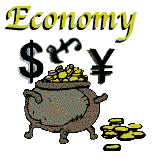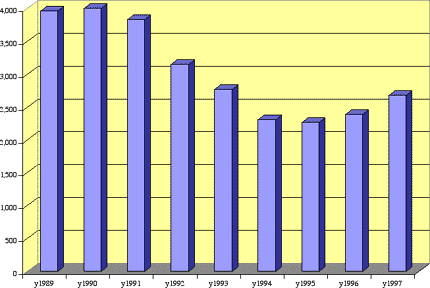|

RUSSIA
GDP (2008): $2.255 Trillion.
Growth rate (2008): 7%
Per capita GDP: $15,800 in 2008
Budget: Income .............. $385.5 Billion
Expenditure ... $273.3 Billion
Main Crops: Grain, sugar beets, sunflower seed, vegetables, fruits; beef, milk.
Natural Resources: Oil, natural gas, coal, and many strategic minerals, timber.
Major Industries: complete range of mining and extractive industries producing coal, oil, gas, chemicals, and metals; all forms of machine
building from rolling mills to high-performance aircraft and space vehicles; shipbuilding; road and rail transportation equipment;
communications equipment; agricultural machinery, tractors, and construction equipment; electric power generating and transmitting
equipment; medical and scientific instruments; consumer durables, textiles, foodstuffs, handicrafts . |
| NATIONAL GNP |
 |
The Russian economy underwent tremendous stress as it moved from a centrally planned economy to a free market system. Difficulties in implementing fiscal reforms aimed at raising government revenues and a dependence on short-term borrowing to finance budget deficits led to a serious financial crisis in 1998. Lower prices for Russia's major export earners (oil and minerals) and a loss of investor confidence due to the Asian financial crisis exacerbated financial problems. The result was a rapid and steep decline (60%) in the value of the ruble, flight of foreign investment, delayed payments on sovereign and private debts, a breakdown of commercial transactions through the banking system, and the threat of runaway inflation.
Still, Russia weathered the crisis well. In 1999, one year after the crisis, real gross domestic product (GDP) increased by the highest percentage since the fall of the Soviet Union, the ruble stabilized, inflation was moderate, and investment began to increase again. Russia is making progress in meeting its foreign debt obligations. RussiaÕs sovereign debt has shrunken rapidly since 1998. High oil prices brought large fiscal surpluses of over 1% of GDP. This has allowed Russia to prepay part of its debt and repurchase private sector debt. RussiaÕs foreign debt fell from 64% of GDP in 2000 to just 28% of GDP in 2003. Russia continues to explore debt swap/exchange opportunities.
An upgrade in RussianÕs sovereign credit ratings by MoodyÕs to Baa3 in September 2003, and upgrade by Standard&PoorÕs to BB+ in January 2004, reflects higher confidence in the Russian GovernmentÕs financial management. Credit ratings for Russian private debt remain low, however. Large current account surpluses have brought a real appreciation of the ruble over the past several years. The trade-weighted exchange rate of the ruble rose by 4% against the currencies of RussiaÕs major trading partners during 2003. Upward pressure on the ruble has been reduced by sterilization of some of the inflows and by channeling some of the governmentÕs fiscal surplus into a stabilization fund. This fund will help cushion Russia from price shocks should energy prices remain low for an extended period. The ruble appreciation of the past several years has given back nearly all of the terms-of-trade advantage that Russia gained when the ruble fell by 60% during the 1998 debt crisis. Loan and deposit rates at or below the inflation rate, as well as a lack of depositor confidence in the Russian banks, inhibit the growth of the banking system and make the allocation of capital and risk much less efficient than it would be otherwise. The Russian government is currently in the process of implementing a deposit insurance scheme as part of its banking reform efforts.
Gross Domestic Product
Russia's GDP grew by 6.8% during 2004 to $613 billion, propelled by high oil prices, moderate inflation (12%), and strict government budget discipline. Real incomes grew by 10%, spurring considerable growth in private consumption. Industrial output in 2003 grew by 7% compared with 2002.
Monetary Policy
The exchange rate stabilized in 1999; after falling from 6.5 rubles/dollar in August 1998 to about 25 rubles/dollar by April 1999, one year later it had further depreciated only to about 28.5 rubles/dollar. As of January 2004, the exchange rate was 28.5 rubles/dollar, an appreciation of the ruble by 4% from January 2003. After some large spikes in inflation following the August 1998 economic crisis, inflation has declined steadily.
Government Spending/Taxation
Central and local government expenditures are about equal. Combined they come to about 38% of GDP. Fiscal policy has been very disciplined since the 1998 debt crisis. The combined budget surpluses during 2002 were 2.3% of GDP and 1% during 2003. Analysts remain skeptical that high rates of economic growth will continue should oil prices decline. However, high oil prices also have negative economic effects over time, as the consequent very large trade surpluses tend to push the ruble higher, making exports of manufactured goods lag. |
|
|


